Cat Eye Health

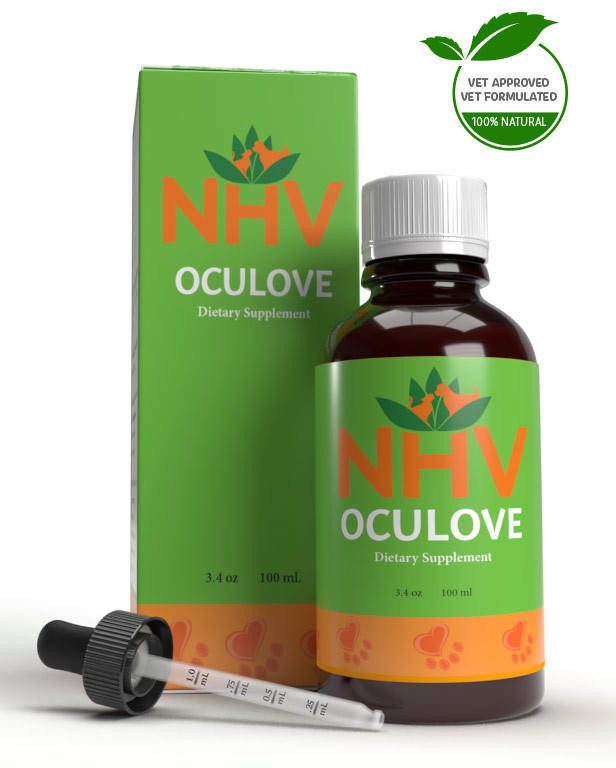
free shipping over SGD 134.95 (USA & Canada)
1-877-937-4372 the pet expert hotline
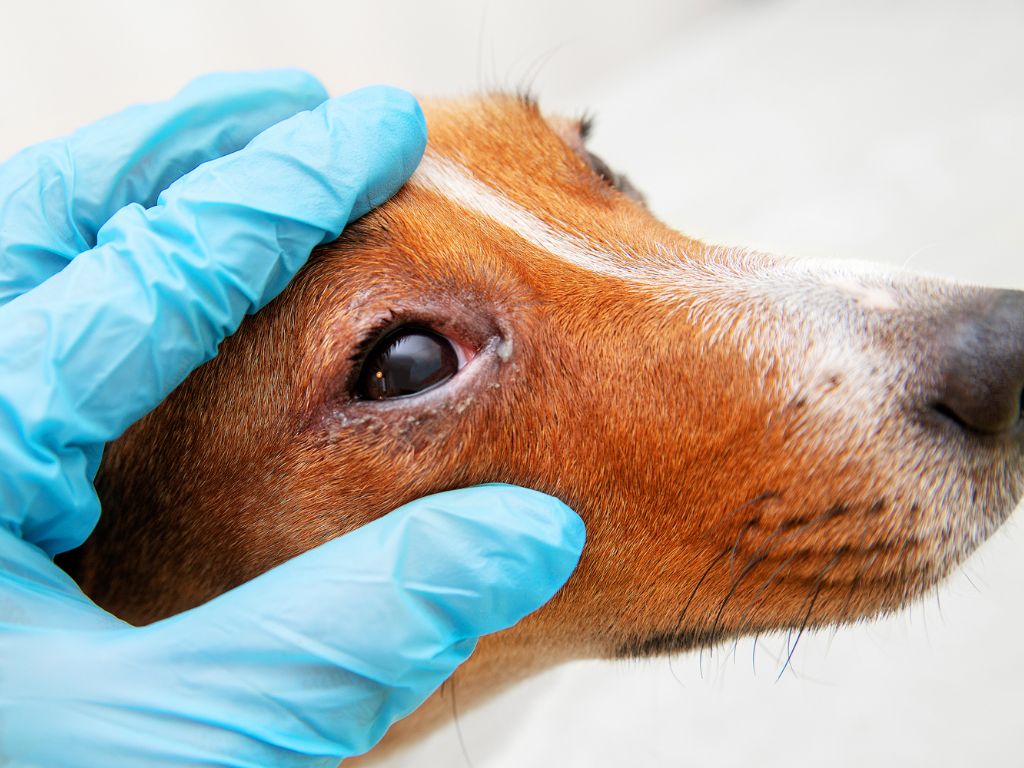
Pannus in dogs, also known as chronic superficial keratitis (CSK), is an eye condition that can lead to vision impairment if left untreated. This issue happens primarily in dogs and is characterized by inflammation and progressive changes in the cornea.
Let’s delve into the various aspects of canine pannus, including possible causes, clinical signs, diagnostic tests, treatment options, and essential care. We will also explore the role of supplements in managing this eye condition.
What is Pannus in Dogs?
Pannus is an immune-mediated eye disease that affects the cornea, the clear outer layer of the eye. The immune system mistakenly targets the cornea, resulting in inflammation and the formation of blood vessels and pigmentation.
What are the Clinical Signs of Pannus?
Clinical signs of pannus in dogs include redness and blood vessel growth on the cornea, cloudiness, pigmentation, increased tear production, squinting, and light sensitivity. As the disease progresses, vision loss can occur.
What Causes Pannus in Dogs?
The exact cause of pannus is still not fully understood, but it is believed to have a genetic predisposition combined with environmental factors. It commonly occurs in certain dog breeds, including German Shepherds, Border Collies, and Greyhounds. Ultraviolet (UV) light exposure and autoimmune responses are also thought to play a role in triggering the condition.
What are the Diagnostic Tests?
To diagnose pannus, a veterinarian will perform a thorough eye examination, including visually inspecting the cornea and measuring tear production. Additional tests, such as corneal staining, tissue biopsy, and blood tests, may be conducted to rule out other potential causes and assess the extent of the disease.
What are the Treatment Options for Pannus?

The primary goal of pannus treatment is to control inflammation, prevent further corneal damage, and preserve vision. Treatment options for dogs may include topical corticosteroids, immunomodulatory drugs, non-steroidal anti-inflammatory drugs (NSAIDs), and occasionally surgical intervention in severe cases.
How Can I Take Care of a Dog with Pannus?
Providing proper care for a dog with pannus is essential to manage the condition effectively. Avoiding excessive UV light exposure by limiting outdoor activities during peak sunlight hours and using protective eyewear can help reduce the progression of pannus. Regular veterinary check-ups and adherence to prescribed medication regimens are crucial.
Dogs with pannus can lead happy and comfortable lives with appropriate treatment and proper care, including natural supplements. Remember to consult with your veterinarian to develop a comprehensive treatment plan tailored to your dog’s specific needs.
These supplements can play a supportive role in managing pannus in dogs:
NHV Oculove: This natural herbal blend is specifically formulated to support eye health, reduce inflammation, and promote healing in the eyes.
NHV Ey Eas: This herbal formulation has antibiotic and anti-inflammatory properties, providing relief for eye irritations and infections, including those associated with pannus.
These supplements can complement the primary treatment prescribed by your veterinarian and contribute to overall eye health.
Cat Eye Health


Natural Support for Eye Health
buy 2 and save SGD 3.95
3 month supply for a small to medium size pet.
No matter how old our dogs get, we like to think of them as puppies forever. Unfortunately, almost all pups will face vision problems during their lifetimes, including issues like glaucoma, cataracts, or infections like conjunctivitis. Supporting canine eye health with NHV OcuLove will help keep those beautiful baby browns healthy for longer.


No matter how old our dogs get, we like to think of them as puppies forever. Unfortunately, almost all pups will face vision problems during their lifetimes, including issues like glaucoma, cataracts, or infections like conjunctivitis. Supporting canine eye health with NHV OcuLove will help keep those beautiful baby browns healthy for longer.

Support for Eye Health in Dogs and Puppies
They say that the eyes are like the windows to the soul. There may be something to that! But if there is cloudiness or redness on the lens or whites of the eyes of your pup, something could be affecting their vision. Problems like glaucoma and cataracts happen more frequently in senior pets. But issues like conjunctivitis (pink eye) or general itchiness can occur at any moment, regardless of breed or age. OcuLove is a natural dog eye vitamin supplement that contains ingredients used for centuries to soothe itchy eyes, relieve inflammation in eyelids and blood vessels, as well as help support dog eye infections, like conjunctivitis or progressive diseases like dog cataracts, and retinal disorders. Rich in vitamin A and antioxidants, OcuLove is a beneficial aid for improving circulation and oxygenation around the eye. This natural eye health supplement is specially formulated by a master herbalist and a holistic veterinarian to be safe for use for all dogs. Puppies should be at least four months old, fully weaned and fully vaccinated for safe use.
How NHV Remedies Support Dog Eye Health
OcuLove is an all natural herbal botanical supplement. The herbs in this blend are known for their eye health benefits. For instance bilberry, which contains anthocyanins - the pigments that give these berries their rich blue color - are naturally occurring compounds with antioxidant and anti-inflammatory properties. Studies have shown that anthocyanins enhance the circulation in small blood vessels and help improve oxygenation around the eye. Improved oxygenation is beneficial for conditions like glaucoma (optic nerve damage), cataracts (clouding of the lens) and retinal disorders (vision impairment). Other ingredients like eyebright and turmeric help to soothe itchiness, inflammation (in eyelids and blood vessels) and may improve various eye conditions that can damage the optic nerve. Gingko Biloba is known as one of the oldest living tree species on earth. Its healing properties include enhancing blood flow, providing better oxygenation (which helps with the conditions mentioned above), and slowing the progression of vision loss in pets with diabetes. Wheatgrass has twice the amount of vitamin A compared to carrots - a food commonly known to improve eyesight. Oregon grape can help against microorganisms and has anti-inflammatory properties that may aid with vision, eye infections, conjunctivitis, red eyes, dry eyes, and eye issues in general.
This natural supplement is veterinarian formulated to help your dog’s eye health.
Support Your Dog’s Health The Natural Way!
At NHV, we are a team of holistic veterinarians, vet techs and pet enthusiasts who want to help your little one improve their health naturally. If you notice any cloudiness or redness in their eyes or they are obsessively scratching them, get in touch with your vet. For any eye health questions, get in touch with an NHV pet expert!
Made with the finest, organically grown, or ethically harvested herbs. Made specifically for pets, vet-formulated and vet approved.
Bilberry — Is a relative of the blueberry. Studies have shown that the anthocyanins in bilberry help various eye issues like glaucoma, cataracts, conjunctivitis, and overall issues that affect the eye. It is known to improve the circulation of the small blood vessels responsible for providing nutrient-rich blood to the cells and oxygenating the blood.
Eyebright — Has been used since antiquity to promote eye health and help to relieve itchy eyes, inflammation of the eyelids (blepharitis) and small blood vessels (conjunctivitis) and may prevent mucus buildup.
Gingko — Is one of the oldest surviving tree species on earth (Gingko Biloba), and has a long history rooted in Traditional Chinese Medicine (TCM). It is known to improve oxygen levels around the eye and in the body and improve conditions like glaucoma, retinal disorders, and vision loss (in pets with diabetes).
Wheat (wheatgrass) — Is rich in vitamin A which is known to improve eyesight. It is also rich in anti-inflammatory, antibacterial, antioxidant properties which may help to soothe dry, red eyes and help to slow down the progression of vision loss caused by various health issues.
Turmeric — Contains Curcumin (the bioactive ingredient in Turmeric) that has can help against microorganisms and has antioxidant, anti-inflammatory, and anti-fungal properties that promote eye health and help fight cell damage (leading to degenerative injury). It may aid with various eye conditions that can cause damage to the optic nerve and possible vision loss.
Oregon grape — Contains anti-inflammatory properties. Studies have found berberine (an antibacterial compound in oregon grape) to help improve vision and fight eye infections, as well as help improve conjunctivitis, red eyes, dry eyes, and strengthening overall healthy immune function.
Select your pet's weight to determine the correct dose.
To be taken twice daily. Determine your pet’s weight and then use the easy chart below to determine the correct dose. This is the minimum dosage.
Pet's Weight Dosage
0 - 15 lb = 0.5 ml
16 - 30 lb = 1.0 ml
31 - 45 lb = 1.5 ml
46 - 60 lb = 2.0 ml
61 - 75 lb = 2.5 ml
Over 75 lb = 3.0 ml
Some pets may require a larger dosage due to their metabolism. You can safely double the recommended dosage.
How to Administer
Shake well before use. Use the dropper provided to squirt the dosage directly into your pet’s mouth along the gums and teeth. Some pets may be finicky and resist your attempts to administer drops directly into their mouth. If this occurs, try placing the drops in your pet’s food or favorite treat. You may want to consider hiding the drops in foods most pet’s love such as fish, chicken, or yogurt. When serving dry food, use the dropper to soak a few kibbles at feeding time.
For Best Results
Herbal dietary supplements are beneficial to the health and wellbeing of your pet and are safe for long-term use. Every pet responds to natural herbal supplements differently, therefore it is important to be consistent and administer the product daily. Supplements generally take two to four weeks to take effect, however this will vary from one animal to the next.
Product Storage
All NHV Natural Pet Products are pure herbal extracts and contain no artificial additives, preservatives or coloring. Shelf life after opening is 6 months and must be refrigerated after opening.
Cautions and Contraindications
Do not use OcuLove in pregnant or nursing animals. Speak to your vet before using our products. A second visit is recommended if your pet’s condition does not improve, or deteriorates after continued use of the supplements.
All information provided by NHV Natural Pet Products is for educational purposes only.
Support for Eye Health in Dogs and Puppies
They say that the eyes are like the windows to the soul. There may be something to that! But if there is cloudiness or redness on the lens or whites of the eyes of your pup, something could be affecting their vision. Problems like glaucoma and cataracts happen more frequently in senior pets. But issues like conjunctivitis (pink eye) or general itchiness can occur at any moment, regardless of breed or age. OcuLove is a natural dog eye vitamin supplement that contains ingredients used for centuries to soothe itchy eyes, relieve inflammation in eyelids and blood vessels, as well as help support dog eye infections, like conjunctivitis or progressive diseases like dog cataracts, and retinal disorders. Rich in vitamin A and antioxidants, OcuLove is a beneficial aid for improving circulation and oxygenation around the eye. This natural eye health supplement is specially formulated by a master herbalist and a holistic veterinarian to be safe for use for all dogs. Puppies should be at least four months old, fully weaned and fully vaccinated for safe use.
How NHV Remedies Support Dog Eye Health
OcuLove is an all natural herbal botanical supplement. The herbs in this blend are known for their eye health benefits. For instance bilberry, which contains anthocyanins - the pigments that give these berries their rich blue color - are naturally occurring compounds with antioxidant and anti-inflammatory properties. Studies have shown that anthocyanins enhance the circulation in small blood vessels and help improve oxygenation around the eye. Improved oxygenation is beneficial for conditions like glaucoma (optic nerve damage), cataracts (clouding of the lens) and retinal disorders (vision impairment). Other ingredients like eyebright and turmeric help to soothe itchiness, inflammation (in eyelids and blood vessels) and may improve various eye conditions that can damage the optic nerve. Gingko Biloba is known as one of the oldest living tree species on earth. Its healing properties include enhancing blood flow, providing better oxygenation (which helps with the conditions mentioned above), and slowing the progression of vision loss in pets with diabetes. Wheatgrass has twice the amount of vitamin A compared to carrots - a food commonly known to improve eyesight. Oregon grape can help against microorganisms and has anti-inflammatory properties that may aid with vision, eye infections, conjunctivitis, red eyes, dry eyes, and eye issues in general.
This natural supplement is veterinarian formulated to help your dog’s eye health.
Support Your Dog’s Health The Natural Way!
At NHV, we are a team of holistic veterinarians, vet techs and pet enthusiasts who want to help your little one improve their health naturally. If you notice any cloudiness or redness in their eyes or they are obsessively scratching them, get in touch with your vet. For any eye health questions, get in touch with an NHV pet expert!
Made with the finest, organically grown, or ethically harvested herbs. Made specifically for pets, vet-formulated and vet approved.
Bilberry — Is a relative of the blueberry. Studies have shown that the anthocyanins in bilberry help various eye issues like glaucoma, cataracts, conjunctivitis, and overall issues that affect the eye. It is known to improve the circulation of the small blood vessels responsible for providing nutrient-rich blood to the cells and oxygenating the blood.
Eyebright — Has been used since antiquity to promote eye health and help to relieve itchy eyes, inflammation of the eyelids (blepharitis) and small blood vessels (conjunctivitis) and may prevent mucus buildup.
Gingko — Is one of the oldest surviving tree species on earth (Gingko Biloba), and has a long history rooted in Traditional Chinese Medicine (TCM). It is known to improve oxygen levels around the eye and in the body and improve conditions like glaucoma, retinal disorders, and vision loss (in pets with diabetes).
Wheat (wheatgrass) — Is rich in vitamin A which is known to improve eyesight. It is also rich in anti-inflammatory, antibacterial, antioxidant properties which may help to soothe dry, red eyes and help to slow down the progression of vision loss caused by various health issues.
Turmeric — Contains Curcumin (the bioactive ingredient in Turmeric) that has can help against microorganisms and has antioxidant, anti-inflammatory, and anti-fungal properties that promote eye health and help fight cell damage (leading to degenerative injury). It may aid with various eye conditions that can cause damage to the optic nerve and possible vision loss.
Oregon grape — Contains anti-inflammatory properties. Studies have found berberine (an antibacterial compound in oregon grape) to help improve vision and fight eye infections, as well as help improve conjunctivitis, red eyes, dry eyes, and strengthening overall healthy immune function.
Select your pet's weight to determine the correct dose.
To be taken twice daily. Determine your pet’s weight and then use the easy chart below to determine the correct dose. This is the minimum dosage.
Pet's Weight Dosage
0 - 15 lb = 0.5 ml
16 - 30 lb = 1.0 ml
31 - 45 lb = 1.5 ml
46 - 60 lb = 2.0 ml
61 - 75 lb = 2.5 ml
Over 75 lb = 3.0 ml
Some pets may require a larger dosage due to their metabolism. You can safely double the recommended dosage.
How to Administer
Shake well before use. Use the dropper provided to squirt the dosage directly into your pet’s mouth along the gums and teeth. Some pets may be finicky and resist your attempts to administer drops directly into their mouth. If this occurs, try placing the drops in your pet’s food or favorite treat. You may want to consider hiding the drops in foods most pet’s love such as fish, chicken, or yogurt. When serving dry food, use the dropper to soak a few kibbles at feeding time.
For Best Results
Herbal dietary supplements are beneficial to the health and wellbeing of your pet and are safe for long-term use. Every pet responds to natural herbal supplements differently, therefore it is important to be consistent and administer the product daily. Supplements generally take two to four weeks to take effect, however this will vary from one animal to the next.
Product Storage
All NHV Natural Pet Products are pure herbal extracts and contain no artificial additives, preservatives or coloring. Shelf life after opening is 6 months and must be refrigerated after opening.
Cautions and Contraindications
Do not use OcuLove in pregnant or nursing animals. Speak to your vet before using our products. A second visit is recommended if your pet’s condition does not improve, or deteriorates after continued use of the supplements.
All information provided by NHV Natural Pet Products is for educational purposes only.
eye health support

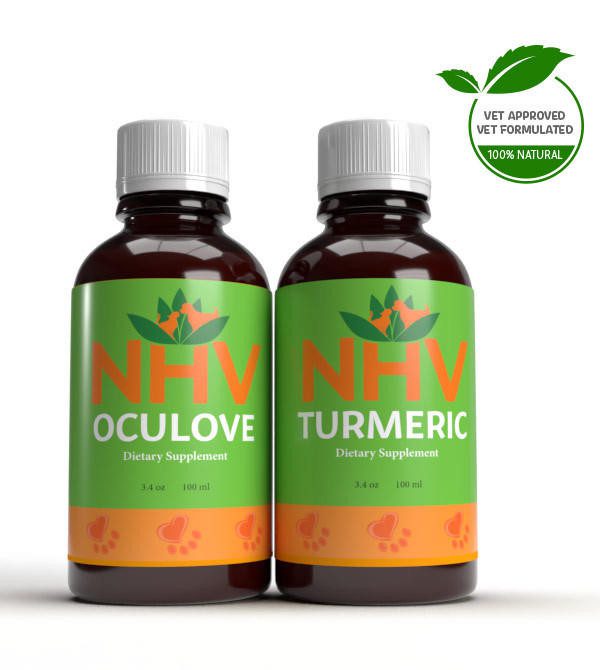
OcuLove & Turmeric
bundle and save with pet expert kits
3 month supply for a small to medium size
Support for Progressive Eye Disease like Glaucoma and Cataracts
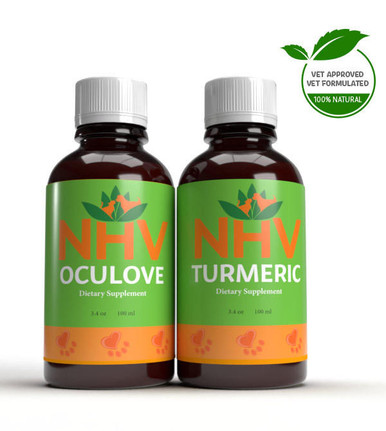
Support for Progressive Eye Disease like Glaucoma and Cataracts
Support for Progressive Eye Disease like Glaucoma and Cataracts in Dogs and Cats
For some of our four-legged friends, conditions like glaucoma or cataracts may be inherited at birth, while others may develop an eye condition later in life due to illness or aging. Our Progressive Eye Health Super Support Kit can be used for proactive pet care and help support cataracts in dogs and cats, cherry eye, tear stains, progressive retinal atrophy (PRA), optic nerve damage and more. We don't know how or when progressive eye disease may strike, but if caught early, we can better manage symptoms and offer the best quality of life to our furkiddos!
NHV's Progressive Eye Disease Super Support Kit contains Oculove and Turmeric.
Oculove's blend of healing herbs is especially beneficial for improving circulation around the eyes, helping to relieve inflammation, and offering relief for conditions like cataracts in dogs and cats, cherry eye in dogs and cats, and glaucoma. Ingredients like bilberry and ginkgo have a long history of use for helping to improve blood circulation around the eyes, and fighting infection. Oculove's all-natural formulation also contains double the amount of vitamin A found in carrots, which are known to help improve eyesight and offer antioxidant support.
Turmeric adds extra antioxidant and anti-inflammatory support to help relieve symptoms of many progressive eye conditions that could cause vision loss and/or optical nerve damage.
As fur parents, we all want our pets to live long and happy lives. It is always tough to watch our little ones age and battle illness. Sadly, some of our four-legged friends will develop some kind of eye issue during their lifetime. Supplements like Oculove and Turmeric are safe for long-term use, and all of our care products are created by a holistic veterinarian and master herbalist with over 50 years of experience. Get in touch with a pet expert if you want to discuss your furkiddo’s ocular health or anything else!
Select your pet's weight to determine the correct dose.
Made with the finest, organically grown, or ethically harvested herbs. Made specifically for pets, vet-formulated, and vet approved.
Eyebright contains antimicrobial and anti-inflammatory properties that may help with conditions such as cherry eye in dogs, cherry eye in cats, cataracts, glaucoma, and more.
Ginkgo has been used for centuries in Chinese medicine to help improve circulation around the eye.
Oregon grape’s antimicrobial, anti-parasitic, and anti-inflammatory properties are beneficial support for conditions like conjunctivitis (pink eye), dry eyes, and more.
Turmeric contains powerful antioxidants that are known to help support eye conditions that may cause damage to the optic nerves and/or vision loss.
Wheat Grass contains twice the vitamin A (when compared to carrots), so it is known to promote healthy eyesight and help slow down progressive eye issues.
Black Pepper is often considered the ‘King of Spices’ due to its flavor, aroma and nutritional density. It contains anti-inflammatory and antioxidant properties that may help improve circulation and help make turmeric more bioavailable.
Turmeric is a spice that has been highly prized for its antioxidant, antibacterial, antifungal and anti-tumor properties. It is especially beneficial for aiding with inflammation and overall circulatory health, promoting health ocular circulation as well as reducing inflammation due to eye conditions.
Support for Progressive Eye Disease like Glaucoma and Cataracts in Dogs and Cats
For some of our four-legged friends, conditions like glaucoma or cataracts may be inherited at birth, while others may develop an eye condition later in life due to illness or aging. Our Progressive Eye Health Super Support Kit can be used for proactive pet care and help support cataracts in dogs and cats, cherry eye, tear stains, progressive retinal atrophy (PRA), optic nerve damage and more. We don't know how or when progressive eye disease may strike, but if caught early, we can better manage symptoms and offer the best quality of life to our furkiddos!
NHV's Progressive Eye Disease Super Support Kit contains Oculove and Turmeric.
Oculove's blend of healing herbs is especially beneficial for improving circulation around the eyes, helping to relieve inflammation, and offering relief for conditions like cataracts in dogs and cats, cherry eye in dogs and cats, and glaucoma. Ingredients like bilberry and ginkgo have a long history of use for helping to improve blood circulation around the eyes, and fighting infection. Oculove's all-natural formulation also contains double the amount of vitamin A found in carrots, which are known to help improve eyesight and offer antioxidant support.
Turmeric adds extra antioxidant and anti-inflammatory support to help relieve symptoms of many progressive eye conditions that could cause vision loss and/or optical nerve damage.
As fur parents, we all want our pets to live long and happy lives. It is always tough to watch our little ones age and battle illness. Sadly, some of our four-legged friends will develop some kind of eye issue during their lifetime. Supplements like Oculove and Turmeric are safe for long-term use, and all of our care products are created by a holistic veterinarian and master herbalist with over 50 years of experience. Get in touch with a pet expert if you want to discuss your furkiddo’s ocular health or anything else!
Select your pet's weight to determine the correct dose.
Made with the finest, organically grown, or ethically harvested herbs. Made specifically for pets, vet-formulated, and vet approved.
Eyebright contains antimicrobial and anti-inflammatory properties that may help with conditions such as cherry eye in dogs, cherry eye in cats, cataracts, glaucoma, and more.
Ginkgo has been used for centuries in Chinese medicine to help improve circulation around the eye.
Oregon grape’s antimicrobial, anti-parasitic, and anti-inflammatory properties are beneficial support for conditions like conjunctivitis (pink eye), dry eyes, and more.
Turmeric contains powerful antioxidants that are known to help support eye conditions that may cause damage to the optic nerves and/or vision loss.
Wheat Grass contains twice the vitamin A (when compared to carrots), so it is known to promote healthy eyesight and help slow down progressive eye issues.
Black Pepper is often considered the ‘King of Spices’ due to its flavor, aroma and nutritional density. It contains anti-inflammatory and antioxidant properties that may help improve circulation and help make turmeric more bioavailable.
Turmeric is a spice that has been highly prized for its antioxidant, antibacterial, antifungal and anti-tumor properties. It is especially beneficial for aiding with inflammation and overall circulatory health, promoting health ocular circulation as well as reducing inflammation due to eye conditions.
eye support
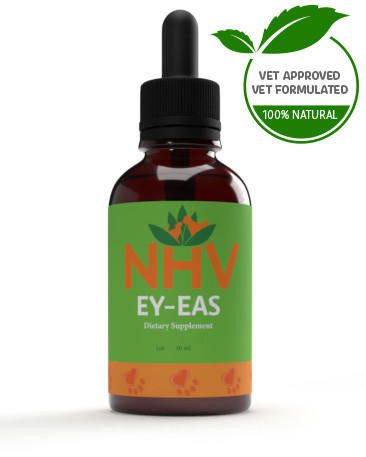
To Manage Uncomfortable Swelling and Restore Eye Health from Pink Eye (Conjunctivitis) and Watery Eyes
buy 2 and save SGD 3.95
Ey-Eas is a dog eye infection remedy that helps soothe discomfort, stressful eye infections and in dogs due to foreign material, bacteria or viral infections such as pink eye (conjunctivitis).

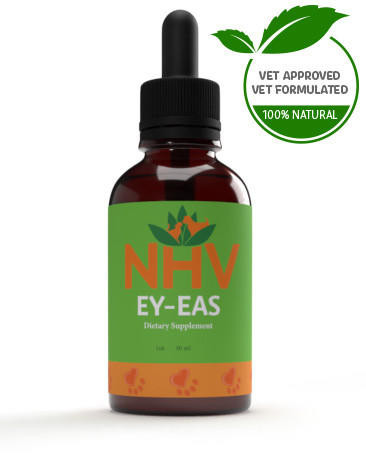
Ey-Eas is a dog eye infection remedy that helps soothe discomfort, stressful eye infections and in dogs due to foreign material, bacteria or viral infections such as pink eye (conjunctivitis).

Dogs may be prone to eye infections that cause discomfort and long-term damage if left untreated. Ey-Eas is a dog eye infection remedy that helps dogs with eyes that are red, cloudy, or bulging. It is also helpful for dogs that are continually rubbing their eyes, tearing excessively, or avoiding light. Conjunctivitis can occur in one or both eyes and is most often the result of a bacterial or viral infection.
Other possible causes include allergies, irritants, and fungal infections. If only one eye is affected, then it may be an inflamed tear sac or a foreign object causing the problem. Do not use with existing corneal ulcers.
Disclaimer: The information provided in relation to the products mentioned is intended for general informational purposes only and should not be construed as professional veterinary advice or a substitute for consultation with a qualified veterinarian. These products are not intended to diagnose, treat, cure, or prevent any pet health condition. Consult a licensed veterinarian before using any product or making changes to your pet's diet, health, or wellness routine. Individual pet health outcomes may vary, and the effectiveness of the product may depend on various factors specific to your pet. Always carefully read and follow the product label and instructions. The manufacturer and distributor of these products do not assume any liability for any direct or indirect consequences that may arise from the use of these products on pets. All information is for educational purposes only.
Chamomile – An excellent calming agent.
Eye Bright – Reduces inflammation and contains strong astringent properties.
Goldenseal – An anti-inflammatory and decongestant that exhibits a broad spectrum of antibiotic activity that works as a dog eye infection natural remedy.
Rosemary – Has anti-inflammatory and antiseptic properties.
Ey-Eas can be used orally or topically.
ORALLY: To be taken twice daily.
1 drops for every 2lb of body weight up to 50 lb.
TOPICALLY: Using the dropper place a few drops in each eye.
Shaking of the head and rubbing of the eyes is normal.
How to Administer
Shake well before use. The easiest method is to use the dropper provide and places the drops into your pet’s food or favorite treat. You can also use the dropper and squirt directly into the pet’s mouth.
Some pets can be finicky, if this occurs consider hiding the drops in foods most pet’s love such as fish, chicken or yogurt or a favorite treat. If your pet only eats dry food then soak a few kibbles at feeding time.
For Best Results
Herbal dietary supplements are beneficial to the health and wellbeing of your pet and are safe for long-term use. Every pet responds to natural herbal supplements differently, therefore it is important to be consistent and administer the product daily. Supplements generally take two to four weeks to take effect, however this will vary from one animal to the next.
Product Storage
All NHV Natural Pet Products are pure herbal extracts and contain no artificial additives, preservatives or coloring. Shelf life after opening is 6 months and must be refrigerated after opening.
Cautions and Contraindications
Do not use Ey-Eas in pregnant or nursing animals. When used topically the pet may shake it’s head or rub its eyes and face for a short time; this normal. Speak to your vet before using our products. A second visit is recommended if your pet’s condition does not improve, or deteriorates after continued use of the supplements.
All information provided by NHV Natural Pet Products is for educational purposes only.
Dogs may be prone to eye infections that cause discomfort and long-term damage if left untreated. Ey-Eas is a dog eye infection remedy that helps dogs with eyes that are red, cloudy, or bulging. It is also helpful for dogs that are continually rubbing their eyes, tearing excessively, or avoiding light. Conjunctivitis can occur in one or both eyes and is most often the result of a bacterial or viral infection.
Other possible causes include allergies, irritants, and fungal infections. If only one eye is affected, then it may be an inflamed tear sac or a foreign object causing the problem. Do not use with existing corneal ulcers.
Disclaimer: The information provided in relation to the products mentioned is intended for general informational purposes only and should not be construed as professional veterinary advice or a substitute for consultation with a qualified veterinarian. These products are not intended to diagnose, treat, cure, or prevent any pet health condition. Consult a licensed veterinarian before using any product or making changes to your pet's diet, health, or wellness routine. Individual pet health outcomes may vary, and the effectiveness of the product may depend on various factors specific to your pet. Always carefully read and follow the product label and instructions. The manufacturer and distributor of these products do not assume any liability for any direct or indirect consequences that may arise from the use of these products on pets. All information is for educational purposes only.
Chamomile – An excellent calming agent.
Eye Bright – Reduces inflammation and contains strong astringent properties.
Goldenseal – An anti-inflammatory and decongestant that exhibits a broad spectrum of antibiotic activity that works as a dog eye infection natural remedy.
Rosemary – Has anti-inflammatory and antiseptic properties.
Ey-Eas can be used orally or topically.
ORALLY: To be taken twice daily.
1 drops for every 2lb of body weight up to 50 lb.
TOPICALLY: Using the dropper place a few drops in each eye.
Shaking of the head and rubbing of the eyes is normal.
How to Administer
Shake well before use. The easiest method is to use the dropper provide and places the drops into your pet’s food or favorite treat. You can also use the dropper and squirt directly into the pet’s mouth.
Some pets can be finicky, if this occurs consider hiding the drops in foods most pet’s love such as fish, chicken or yogurt or a favorite treat. If your pet only eats dry food then soak a few kibbles at feeding time.
For Best Results
Herbal dietary supplements are beneficial to the health and wellbeing of your pet and are safe for long-term use. Every pet responds to natural herbal supplements differently, therefore it is important to be consistent and administer the product daily. Supplements generally take two to four weeks to take effect, however this will vary from one animal to the next.
Product Storage
All NHV Natural Pet Products are pure herbal extracts and contain no artificial additives, preservatives or coloring. Shelf life after opening is 6 months and must be refrigerated after opening.
Cautions and Contraindications
Do not use Ey-Eas in pregnant or nursing animals. When used topically the pet may shake it’s head or rub its eyes and face for a short time; this normal. Speak to your vet before using our products. A second visit is recommended if your pet’s condition does not improve, or deteriorates after continued use of the supplements.
All information provided by NHV Natural Pet Products is for educational purposes only.